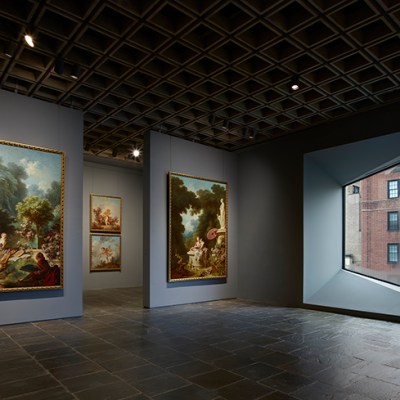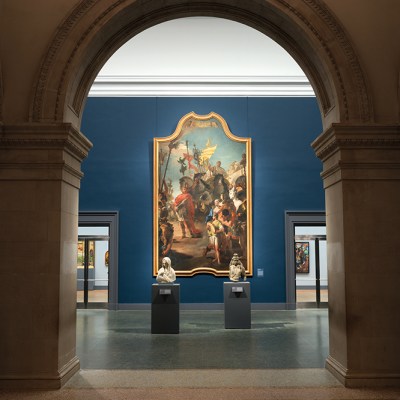One of 2024’s most highly anticipated museum reopenings was that of the Frick Collection in New York, whose Fifth Avenue home has been closed since 2020 for extensive renovations. On the cusp of 2025, the doors of Beaux-Arts mansion that houses Henry Clay Frick’s magisterial collection of Old Masters and decorative art are still firmly shut. The Frick will, however, be reopening in April 2025, showing off its restored exhibition spaces, a suite of new galleries on the second floor and a full refurbishment of the Art Research Library and Reading Room by Selldorf Architects.
The Frick is just one of a number of openings in what promises to be a busy year for US cultural institutions. These include the Yale Center for British Art – which holds the most extensive collection of British art outside the UK – whose Louis Kahn-designed glass and steel home will reopen in March after conservation work that has involved replacing the roof, skylights and lighting systems, and the Michael C. Rockefeller Wing at the Met, dedicated to art from Oceania, sub-Saharan Africa and the ancient Americas, which has been closed for renovation and a major rehang since 2021 and will reopen to the public in May. On the other side of Manhattan, the Studio Museum in Harlem, which was set up in 1968 primarily to show works by Black artists, will unveil in the autumn its brand new building – an invitingly asymmetrical tower of dark grey concrete and large glass panels. In a nod to the museum’s history, the first exhibition at the new building will be a survey of the sculptor and installation artist Tom Lloyd, whose light installations also featured in the very first show at the Studio Museum in the rented loft that was its original home.
Unknown woman (c. 1675), Mary Beale. Yale Center for British Art, New Haven

In London, two museum projects are scheduled to be completed. The National Gallery’s Sainsbury Wing, currently undergoing a £35m refurb and rehang of its collection of early Renaissance art, will reopen in May – a coda to NG200, the museum’s £85m programme of capital projects that formed part of its bicentenary celebrations. Selldorf Architects has been drafted in for this project, too, remodelling the wing to let in more light, replacing the gallery’s heavy grey pillars with oak-clad ones and lightening the dark glass in the galleries. The project has not been met with unanimous enthusiasm: some are concerned that the wing, designed by Venturi and Scott Brown in the 1990s, is set to lose some of its quirkiness. Controversy is at least consistent with the Sainsbury Wing’s history: the original proposals in the 1970s were branded by the then Prince of Wales a ‘monstrous carbuncle’, which led to the Sainsbury family stepping in and funding a new project, which opened in 1991.
Away from the centre of the capital, the V&A East Storehouse is due to open in May – a prelude of sorts to V&A East, which will be unveiled in 2026. The Storehouse, which forms part of East Bank, the new cultural development in the Queen Elizabeth Olympic Park in Stratford, is a four-storey open-plan smorgasbord of display racks containing more than 250,000 objects and 350,000 books, offering pop-up displays, behind-the-scenes views of conservation work and a system by which visitors can ‘order an object’ to see up close and, in some cases, handle themselves. The David Bowie Centre, built to house the Bowie archive (comprising some 80,000 items) that the V&A acquired in 2023, will open as part of the Storehouse in September, displaying instruments, costumes, photographs, sheet music and assorted oddities associated with the musician.
It seems unlikely that Rotterdam will usurp Amsterdam or The Hague as the centre of the Dutch art world in the immediate future, but the city is making a play for it with a long-term programme of ambitious investments in its cultural institutions. One of the major projects opening there in 2025 is Fenix, a museum dedicated to the theme of migration, located on the harbour that from 1873 to 1989 welcomed and bade farewell to millions of migrants travelling between Europe and the United States. Fenix involves a major renovation by MAD Architects of the harbour-side warehouse that was built in 1923 – at one point the largest building of its kind in Europe – and is topped with ‘the Tornado’, a swirling metallic walkway that will allow visitors striking views of the Rotterdam skyline.
Fenix at dusk in 2024. Photo: © Gregg Telussa

The Museum of Modern Art in Warsaw offers a story of migration in a different sense: since its establishment in 2005 it has been something of a roving institution, but has now found a new permanent home in the centre of the Polish capital. The $145m building, designed by Thomas Phifer and Partners, is a sleek white box of a building with a cavernous glass-roofed atrium. The building was opened to the public in October 2024, but visitors will have to wait until February to see the unveiling of the museum’s extensive collection of 20th- and 21st-century art. Norway, meanwhile, is continuing to enrich its artistic scene with the opening of PoMo, a museum in Trondheim housed in a renovated art-nouveau post office building that will exhibit a collection of modern and contemporary works by Louise Bourgeois, Sol LeWitt, Franz West and many others.
2024 was a big year for Adriano Pedrosa, who curated the main exhibition at the Venice Biennale. He is set to have another hectic year: the São Paulo Museum of Art (MASP), the museum of which he is artistic director, will open its new extension: a 14-storey building next to the existing gallery space and connected to it by an underground tunnel (which will come into operation later in the year). The museum was established in 1947 by Assis Chateaubriand and Pietro Maria Bardi and its main building is considered to be the masterpiece of the architect Lino Bo Bardi (who was married to Pietro Maria Bardi). The $43 million project by the architects Martin Corullon and Gustavo Cedroni of Metro Arquitetos Associado has been funded entirely by private donations.
If the many delays in the eventual opening of the Louvre Abu Dhabi in 2017 are anything to go by, we may be waiting a while for the Zayed National Museum and the Guggenheim Abu Dhabi. But the museums, both of which were announced in the 2000s and have been beset by reneged-on loan agreements and accusations of working conditions that amount to ‘modern slavery’, are scheduled to be completed in 2025 in the Saadiyat Island district, though no opening date has yet been confirmed. The former will be dedicated to the history and culture of the country, housed in Norman Foster’s futuristic stadium-like megalith and adorned with five thermal towers shaped like giant falcon wings. The latter is designed by Frank Gehry – architect of the Guggenheim Bilbao – and will become the largest museum in the Guggenheim family.


